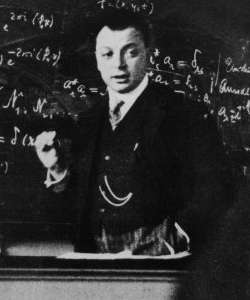Pauli exclusion principle
The Pauli exclusion principle is a fundamental principle in quantum mechanics formulated by the Austrian physicist Wolfgang Pauli in 1925. This principle states that no two fermions can occupy the same quantum state simultaneously within a quantum system. Fermions are particles with half-integer spin, such as electrons, protons, and neutrons.
Overview[edit | edit source]
The Pauli exclusion principle is essential for understanding the structure of atoms, molecules, and solids. It explains a wide range of physical phenomena, including the periodic table of elements, the stability of matter, and the properties of white dwarfs and neutron stars.
Quantum States and Fermions[edit | edit source]
In quantum mechanics, a quantum state is defined by a set of quantum numbers that describe the properties of a particle. For electrons in an atom, these quantum numbers include the principal quantum number (n), the azimuthal quantum number (l), the magnetic quantum number (m), and the spin quantum number (s). According to the Pauli exclusion principle, no two electrons in an atom can have the same set of quantum numbers.
Applications[edit | edit source]
Atomic Structure[edit | edit source]
The Pauli exclusion principle is crucial in determining the electronic configuration of atoms. It explains why electrons fill atomic orbitals in a specific order, leading to the structure of the periodic table. For example, the principle dictates that the 1s orbital can hold only two electrons with opposite spins.
Solid State Physics[edit | edit source]
In solid state physics, the Pauli exclusion principle helps explain the behavior of electrons in metals and semiconductors. It is responsible for the formation of energy bands and the distinction between conductors, insulators, and semiconductors.
Astrophysics[edit | edit source]
In astrophysics, the Pauli exclusion principle plays a vital role in the stability of white dwarfs and neutron stars. In these dense stellar remnants, the principle prevents electrons or neutrons from being compressed into the same quantum state, providing a degeneracy pressure that counteracts gravitational collapse.
Historical Context[edit | edit source]
Wolfgang Pauli proposed the exclusion principle in 1925 to explain the observed patterns in atomic spectra and the structure of the periodic table. The principle was later incorporated into the broader framework of quantum mechanics developed by Werner Heisenberg, Erwin Schrödinger, and others.
See Also[edit | edit source]
References[edit | edit source]
External Links[edit | edit source]
Search WikiMD
Ad.Tired of being Overweight? Try W8MD's physician weight loss program.
Semaglutide (Ozempic / Wegovy and Tirzepatide (Mounjaro / Zepbound) available.
Advertise on WikiMD
|
WikiMD's Wellness Encyclopedia |
| Let Food Be Thy Medicine Medicine Thy Food - Hippocrates |
Translate this page: - East Asian
中文,
日本,
한국어,
South Asian
हिन्दी,
தமிழ்,
తెలుగు,
Urdu,
ಕನ್ನಡ,
Southeast Asian
Indonesian,
Vietnamese,
Thai,
မြန်မာဘာသာ,
বাংলা
European
español,
Deutsch,
français,
Greek,
português do Brasil,
polski,
română,
русский,
Nederlands,
norsk,
svenska,
suomi,
Italian
Middle Eastern & African
عربى,
Turkish,
Persian,
Hebrew,
Afrikaans,
isiZulu,
Kiswahili,
Other
Bulgarian,
Hungarian,
Czech,
Swedish,
മലയാളം,
मराठी,
ਪੰਜਾਬੀ,
ગુજરાતી,
Portuguese,
Ukrainian
Medical Disclaimer: WikiMD is not a substitute for professional medical advice. The information on WikiMD is provided as an information resource only, may be incorrect, outdated or misleading, and is not to be used or relied on for any diagnostic or treatment purposes. Please consult your health care provider before making any healthcare decisions or for guidance about a specific medical condition. WikiMD expressly disclaims responsibility, and shall have no liability, for any damages, loss, injury, or liability whatsoever suffered as a result of your reliance on the information contained in this site. By visiting this site you agree to the foregoing terms and conditions, which may from time to time be changed or supplemented by WikiMD. If you do not agree to the foregoing terms and conditions, you should not enter or use this site. See full disclaimer.
Credits:Most images are courtesy of Wikimedia commons, and templates, categories Wikipedia, licensed under CC BY SA or similar.
Contributors: Prab R. Tumpati, MD

